Are trauma and memory walls and bridges to the truth?… “The premise for this … film comes from an Ono film score, published in 1968: The cameraman will chase a girl on a street with a camera persistently until he corners her in an alley, and, if possible, until she is in a falling position. The execution … is one of the most violent and sexually charged movies ever made–even if flesh never touches flesh. … In one sense, Rape is a particularly brutal dramatization of the Warholian discovery that the camera‘s implacable stare disrupts “ordinary” behavior to enforce its own regime. In another, the film is a graphic metaphor for the ruthless surveillance that can theoretically attach itself to any citizen of the modern world.» ( James Hoberman )
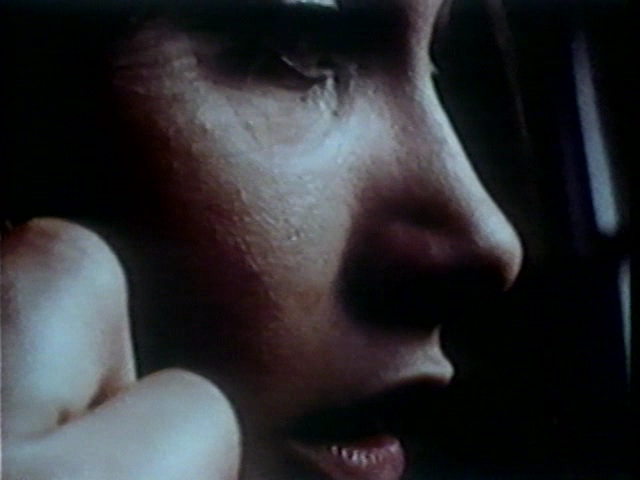
Hoberman:Even more frantic and oppressive, Rape’s second half has the crew invade the small apartment where Majlath is staying. She paced like a caged animal, the camera’s tight, hand-held close-ups mirroring her agitated movements as she compulsively combs her hair, babbles hysterically in German (tears of frustration streaking her elaborate eye makeup), and repeatedly attempts to open the apartment’s locked front door. All the more violent for its sunbursts and whiteouts, this section often becomes pure kinesis. Although Majlath hides her face or halfheartedly blocks the lens, the camera shows no restraint, swarming around her opportunistically coming in closer whenever she appears most vulnerable. As the movie ends, she makes a phone call; the sounds of her distress continue over the credits. A brief coda has Ono and Lennon dourly distorted by an extreme wide-angle lens, singing something like »Everybody had a hard year.«
…”So long ago: was it in a dream? Was it just a dream?” The John Lennon song from “Walls and Bridges” implies that reality and unreality are two sides of one coin in this dream existence. Indeed, the difference between them is only a question of realisation. Once it has been dreamed, once it has been imagined, the concept or feeling can be realised, even if the realisation is itself an act of imaginative recreation.Why does the wind blow Lennon’s mind in Because? Because, he says, it is high. But why “because”? It is a poetic way of expressing an impression of the ineffable reality of existence:
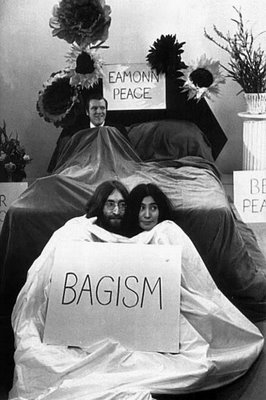
---On March 31st 1969, John Lennon and Yoko Ono gave a press conference at the Sacher Hotel in Vienna, Austria. This was the first announcement of 'Bagism,' which they describe as "total communication." It occured to the Lennons during their Bed-in for Peace event in Amsterdam that some people tended to automatically write-off the younger generation, and realized that perhaps even the Lennons' own general hippy appearance might likely close certain people's minds to their peace message. The concept of Bagism might be summed up in this way: By removing the obsticle of prejudging someone according to the length of their hair or the color of their skin, certain people might be more inclined to take the words and ideas of others more seriously. Hence, total communication. Effectively making this point in their usual disarmingly-humorous way, John and Yoko gave this entire press conference from the inside of a bag. They could not be seen, only heard.---
Because the world is round it turns me on.
Because the world is round. Ah …ah!
Because the wind is high, it blows my mind.
Because the wind is high.
Ah … love is old, love is new. Love is all, love is you.
Because the sky is blue, it makes me cry.
Because the sky is blue. Ah … ah!
Was it just a dream? To repair the past is really to repair oneself; the idea being because I am the past, a past which is present in some mysterious way to the ever-manifesting moment, and is always opening onto the future. So much is involved in this concept of repairing the past that it defies definitive resolution.Nonetheless, as Lennon felt, the temptation to retreat before the challenge should be resisted. Another recurrent connection in Lennon’s lyrics is the link made between pain and artistry. In his Rolling Stone interview, Lennon said that it was pain which had made the great artists what they were, as if this objective sensoral reality was needed to stir the spirit from its dream state.
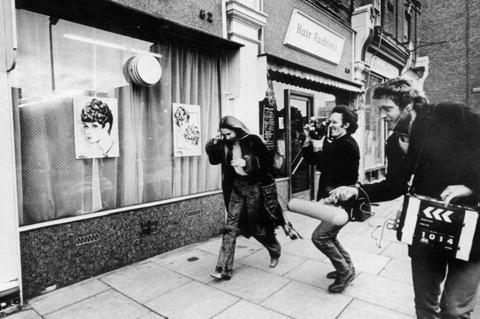
Mark Richardson:My suggestion is that, whilst we should be open to the idea that a chink in the armour may appear anywhere at anytime, artworks, like Rape and flash mobbing, which violently disrupt time, place and identity, might be particularly “worth watching”. New media technologies (from 16mm filmmaking in the 1960s to the internet and mobile phone text messaging today) frequently provoke nerves amongst the Establishment and it is the very vagueness of this nervousness which might present revolutionary opportunities. If the Establishment cannot quite put its finger on the dangers then it is entirely possible that those dangers might lie outside of knowledge and therefore be ripe for the Truth-Event to come along. Perhaps Badiou is right in his claim that an aesthetic truth can never yield a political truth-event; but, then, does it not make some sense to consider Yoko Ono's Rape to be a political act, rather than an artistic work, in any case?
There is always a tension between dream and memory, human pain and freedom.In Lennon’s unreleased ”Tennessee”, there is a focus on the role of the artist in expressing even the bleakest reality so cle
that it shows a way forward for the future. In a later version called “Memory”, at least in the rough draft that is available, though not a final form, the emphasis is on the pain.
Memory, oh memory, what you do to me?
Today is all I really need to know.
Why do you have to haunt me when I thought I’d let you go?
I hear voices whispering through the cold and lonely hall.
Memory, memory, release me from your spell.
Why do you have to haunt me always?
Why do you have to haunt me when I thought you’d run away?
What’s this all about? The song obviously has to do with psychological entrapment and freedom. Lennon feels that he’s haunted, under a spell. He is bewildered: “what you do to me?” The spell is purely within his own skull; it’s the flip side of the liberating magic he conjured in “#9 Dream”. Significantly for the total feel of the song, Lennon uses the noble music he originally wrote for “Tennessee”. What’s going on, then?

Hoberman:For Yoko Ono, an artist who has frequently worked with the notion of »notoriety,« fame has had the paradoxical effect of obscuring her actual achievements. Take Rape. The most powerful and disturbing of the various concept movies that she and John Lennon produced, it’s also a work that, up until now, has been all but written out of film history—unclaimed by the British, cinetheoretical, and feminist avant-gardes, the victim of an inverted snobbery complicated by cultural amnesia.
… Yoko Ono’s film “Rape”, (Yoko Ono and John Lennon, 1969), can be seen as a Yoko version of “Memories” and “No. 9 Dream”, or at least complementary to it. Some of the ideas of Lennon’s “There’s a Place” are inverted to bleak finality when there is no place:An interpretation of Theodor Adorno’s dictum on the barbarity of writing poetry after Auschwitz. The seventy-seven minute, black-and-white documentary turns an unsuspecting young woman ,Eva Majlata, into both participant and victim as she is apparently selected at random and pursued through the streets of London by Ono’s cameraman, Nic Knowland. With Ono having conspired with Majlata’s sister to set her up, Knowland chases the terrified woman- who is living in Britain illegally and speaks virtually no English- back to her sister’s apartment. The film ends with Majlata curled up on the floor, shielding her face from the intruder. Forty years having lapsed, our response to this infamous experiment in cinema verite is that harrowing and relevant ;”Rape” in political terms, the individual’s loss of power, and sense of helplessness is an enigma of postmodernism. …
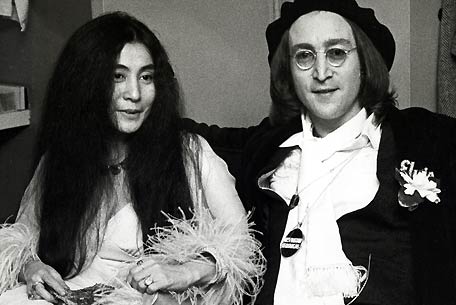
Mark Harrison:So in what sense does this framework relate to Yoko Ono's film Rape? Hawkins is absolutely correct to identify the importance of gaze theory in any analysis of the film. To this, however, I wish to add the suggestion that it was the patriarchal gaze which, whilst belonging to the situation of women in 1969, was not “counted” by it – in other words, the gaze was not an acknowledged part of Being. Rape became an Event by transforming the invisible gaze of patriarchal/colonial power into the concrete gaze of a film camera.
…That makes the music anomalous, as Lennon so often was. If the music of “Memory” is deep, the lyrics are puzzling. What is the point of saying: “Today is all I need to know, so stop bothering me, memories?” If anything, memories serve a purpose: they call one to be present before them. There are very different sorts of memories; each centre has its own proper memory. The memories Lennon is speaking of here sound to me as if they are associations in formatory apparatus, and that the painful feelings they evoke are negative emotions. Negative emotions, of course, are likely and hopefully, not sourced in the feeling centre, but are a sort of growth drawn from the perversion of instinctive centre. A freedom from our memory… if memory serves us well.
As Yoko’s “Rape” showed, post-modernism has left us with a language of signifiers, a landscape of signifieds, and a graveyard of signs with no base reality, and Jean Baudrillard and Walter Benjamin fault mass media and consumerism. “In Baudrillards’s descriptive account of postmodern simulation, the McLuhanesque slogan that the medium is the message reaches an estranging, postmodern limit where the medium of telecommunication infiltrates, mimics, mutates, and finally exterminates the Real like a virus or genetic code, in what Baudrillard describes a a global satellization of the real.” John Lennon knew the power of language, of words. His one comment “We’re more popular than Jesus Christ” sent millions of kids and their brown-shirted parents into a record burning bonfired frenzy. He knew from experienced how loaded the word peace or the word love were, and that they had great signifying power. ( Gregory Mansur )
If “I am present”, life is real,- perhaps the essence of responsibility-, and these associations and negative emotions lose their power. But is it enough to displace them for a time? At some point they have to be acknowledged, responsibility accepted, suffering sacrificed, and a few lessons learned. Perhaps this is Lennon’s problem. Lennon wants to escape the pain: that is understandable. The pain is a providential arrangement to make us take action. But what action? Just waiting for the beast is not too proactive, especially not in the case of memories and negative emotions. For Lennon, was the failure purely imaginary? That something in him feeling blame or regret, as if he could or should have done more. It may be absurd or it may be quite right.
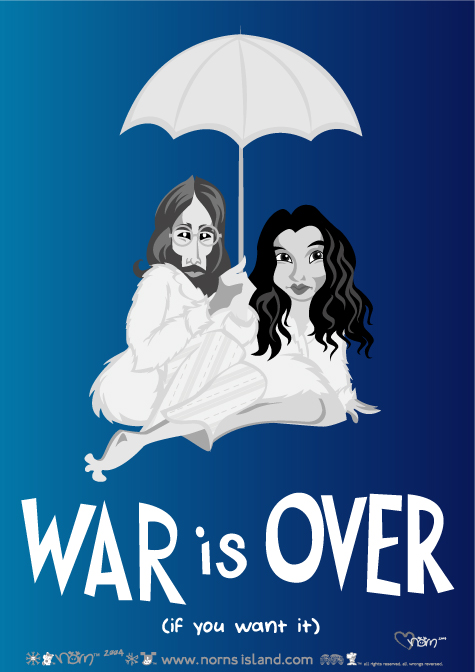
Mansur:THE WAR IS OVER, if you want it. It was a polemic statement of fact, an ‘actualization’ of proletarian power, reminding the masses they have a choice in determining the outcome of a war. Lennon’s use of the media to disseminate an idea within the channels of material consumption runs parallel to Holzer’s. Both are a subversive act, an act of cultural intervention, for the discourse of advertising stands out as a ripe medium for the tactical subversion of dominant slogans and stereotypes.
There does seem to be two types of suffering: conscious and unconscious suffering. The first has a future, since it touches on the notion of human potential. But Lennon in “Memories” and “No.9 Dream”, speaks of is unconscious suffering, and that passing from the shadowland to the light to make it conscious, and by extension to turn regret into remorse. An exercise in exorcism of sorts. When tormented by painful memories, it often seems as if these people are inside. This subliminal sense that other people, – even our old self – are inside, is a common and relatively mild form of possession. A vaporous form of materialism based on accumulation without ostensible purpose. It is, if you like, possession by one’s own associations, and so Lennon’s reference to haunting is terribly accurate. A good example is found in Bernie Taupin’s lyrics for “The Boy in the Red Shoes” from Elton John’s Songs from the West Coast album: “It’s all inside my head, the boy in the red shoes is dancing by my bed”. Though all this can be construed as humorous , a mild form of possession, is still not to be underestimated, because it’s a function of our lack of being at some level. When these “possession” accumulate to an untenable degree, there has to be a volcanic eruption and on a global scale this has meant war.
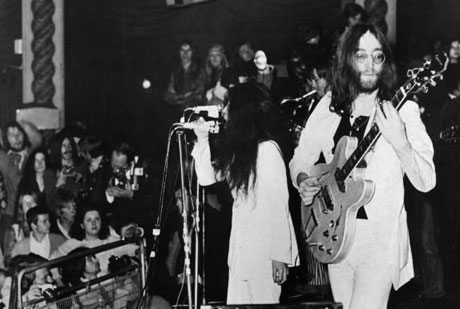
Mansur:Lennon-Ono’s statements for Peace were turned into cultural headlines, thirty-second commercials, cultural signifiers not of peace and love but in the words of Walter Benjamin, the cult of personality. What was being said was secondary to who was saying it. Peace and love was consumed as a textual representation of John Lennon, not his message. The media’s focus was not on Peace or love but on John Lennon and his wife Yoko Ono. The message was lost in signification. John Lennon’s Peace Now was soon replaced by John Travolta’s Saturday Night Fever, soon followed by Ivan Boesky’s hit song “Greed is Good!”
Oh, my love, for the first time in my life, my eyes are wide open.
Oh, my love(r), for the first time in my life, my eyes can see.
I see the wind, oh, I see the trees.
Everything is clear in my heart.
I see the clouds, oh, I see the sky.
Everything is clear in our world.
Oh, my love, for the first time in my life, my mind is wide open.
Oh, my love, for the first time in my life, my mind can feel.
I feel sorrow, I feel dreams.
Everything is clear in my heart.
I feel life, I feel love.
Everything is clear in our world. ( John Lennon)
ADDENDUM:
Immediately after Rape was released to the public in 1969, Ono and Lennon faced a barrage of hostile criticism from the press (who interpreted the film as being a comment on the press intrusion about which the celebrity couple frequently complained). The criticisms were focused on the obvious ethical concerns around forcing Majlata to participate in the film against her will. Within the moral horizon of the time, as a question of knowledge, it may well be that what Ono and Lennon did was wrong. However, if we are to submit Rape to examination under Badiou’s framework of the Truth-Event, then questions of moral knowledge suddenly become less relevant (perhaps even completely irrelevant if we consider that the Truth-Event shatters the preceding positive ontological order of Being). Back in 1969, Ono seemed at least intuitively aware of this when, sitting alongside her husband and co-director, she told an aggressive reporter at a press conference to “leave our morals alone.” Whereas Hawkins describes this attitude as “an uncharacteristic act of what Jean-Paul Sartre would have called ‘bad faith’,” it is my belief that Ono (who studied philosophy at Gakushuin University in the 1950s) was well aware that the film, as a revolutionary critique of the capitalist system, could not possibly be morally integrated within that system. Zizek points out that: “Badiou calls the language that endeavours to name the Truth-Event the ‘subject-language’. This language is meaningless from the standpoint of Knowledge, which judges propositions with regard to their referent within the domain of positive being.” ( Harrison )

Martin Jay on Walter Benjamin:Scornfully rejecting the ways in which culture--at least in its "affirmative" mode--can function to cushion the blows of trauma,20 he wanted to compel his readers to face squarely what had happened and confront its deepest sources rather than let the wounds scar over. Rather than rebuilding the psychological "protective shield" (Reizschutz) that Freud saw as penetrated by trauma, he labored to keep it lowered so that the pain would not be numbed. For the ultimate source of the pain was not merely the war itself.
Mark Harrison: What the Truth-Event renders visible is the one excessive element which is a part of the situation being submitted to the Truth-Process, but not counted within the positive structure of Being. By rendering this excessive element visible (whatever it may be), the preceding positive ontological order must radically change. And it is this formal relation between the Event and the Truth of the situation it articulates/renders visible, which allows us to distinguish between a genuine Event and its mere semblance. To elaborate by example, Zizek explains: “Nazism was a pseudo-Event and the October Revolution was an authentic Event, because only the latter related to the very foundations of the Situation of capitalist order, effectively undermining those foundations, in contrast to Nazism, which staged a pseudo-Event precisely in order to save the capitalist order.”
Martin Jay:This generalization was evident, inter alia, in his influential discussion of Baudelaire’s response to the shocks of modern life. Although he clearly admired the poet’s ability to transform his dueling with those shocks into aesthetic creativity and saw him as a pioneer of post-auratic art, he also understood that at times, to cite Michael Levine, “the very defense that was supposed to intercept the shocks of urban life itself turns out to be something that must be defended against.” Baudelaire’s lyric parrying of distressful stimuli, Benjamin implied, could serve to prevent them from becoming truly traumatic, keeping them, that is, at the level of unreflected episodes with no long-term effect on the mind, which failed to register them beyond the moment of impact. Although he understood the reasons for doing so, and indeed has often been read as simply endorsing the poet’s heroic stance, Benjamin also tacitly warned against the risks of such defensiveness, which was of a piece with other techniques of anaesthesia developed in the nineteenth century to dull the pain of modern life.








 COMMENTS
COMMENTS



